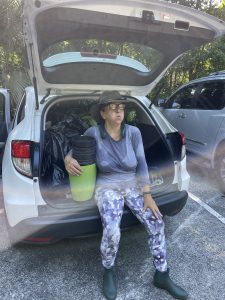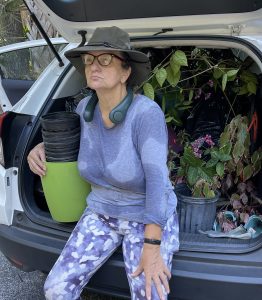 Woah! Who turned up the heat? It seems with temperatures consistently reaching into the upper 90’s, that summer started early and intends to be l-o-n-g! This doesn’t mean we can’t keep gardening, but it does mean that we need to take extra precautions when we work outside.
Woah! Who turned up the heat? It seems with temperatures consistently reaching into the upper 90’s, that summer started early and intends to be l-o-n-g! This doesn’t mean we can’t keep gardening, but it does mean that we need to take extra precautions when we work outside.
There are many dangers that go along with gardening in the summer, including:
-
-
-
- heat rashes
- fainting
- heat cramps
- heat exhaustion
- heat stroke
-
-
Anyone can experience these issues, but certain groups of people are more at-risk than others. Older people, young children, people with heart problems, pregnant people, unfit or overweight people, and people who have not acclimated to working in the heat are most at risk.
Fainting, Heat Exhaustion, and Heat Stroke
Fainting, heat exhaustion, and heat stroke require immediate action. They are caused when the body’s natural cooling processes don’t work as they should. Fainting can happen when the body tries to cool itself by pumping warm blood to the skin. However, if the person is stationary, whether sitting or standing, the blood will collect in the lower part of the body, causing the brain to not get enough blood flow, and the person faints. If you are with a person who has fainted, have them lie down somewhere cool, drink water, and elevate their feet and legs. They should also consult with a doctor.
Heat Exhaustion
Heat exhaustion is caused from sweating out excessive body fluids and salts and decreased blood flow to the brain and other organs. If you experience dizziness, headache, nausea, weakness, or confusion, and your skin is cool and pale, it could be heat exhaustion. Lie down somewhere cool, elevate your feet, remove excess clothing, and drink cold fluids. Be careful about going into the air conditioning immediately, as this can cause some people to pass out.
Heat Stroke
Heat Stroke requires immediate medical attention. Some symptoms of heat stroke are confusion, chills, headache, nausea, dizziness, convulsions, and unconsciousness. The skin will feel hot and dry. To help someone who may be having a heat stroke, you should first call for an ambulance. Next, remove their outer clothing and apply cold water or ice packs to their skin or immerse them in cold water if possible. Do not give a person with heat stroke anything to drink. If you are alone and suspect you are experiencing a heat stroke, call 911 immediately. Heat stroke can be fatal.
Heat rashes and heat cramps
Heat rashes and heat cramps are not as serious and probably won’t land you in the hospital, but still should not be ignored. A heat rash looks like red blotchy skin or clusters of pimples or small blisters. It occurs when sweat doesn’t evaporate from your skin and clogs your pores. To soothe your skin, keep it dry and treat with corn starch.
Pain or cramping in your legs or stomach from loss of fluids and electrolytes can be helped by massaging the muscles and drinking lots of water.
Fortunately, there are several things you can do to prevent overheating illnesses.
- Garden early in the morning or in the evenings to avoid the most intense heat of the day.
- Make sure you are drinking water whether you are thirsty or not.
- Take a break in the shade at least every two hours.
- Wear lightweight, light colored clothing.
- Avoid caffeine, alcohol, and large amounts of sugar as those can speed up dehydration.
If possible, ramp up to long gardening sessions to get your body used to the heat.

As the humidity and heat start to rise, so should your vigilance to keep yourself hydrated and safe as you garden and have fun outdoors.
[This post is written by Extension Agent, Tonya Ashworth, and was previously published in the Florida Times Union. The photos are of MGV, Juliet Johnson – a Brit – who gets very overheated very quickly. Who sweats on their shoulders?!]
 2
2
